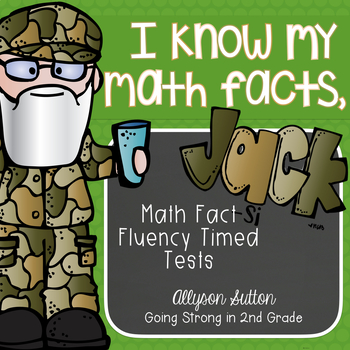I don't know about you but every year one of my big goals in math is for them to master their basic addition and subtraction math facts.
When I was student teaching, the teacher and grade level that I student taught with did minute math fact fluency tests. These tests are not all +1, +2, +3, and so on. My thought with doing fact fluency tests like that are that the kids are learning the pattern - not actually learning the facts so that they can whip out the answer when you give them the problem in day-to-day math problems.
I have used these fact fluency tests each year that I have taught (so 4 years), and a little over a year ago, I gave them a major facelift from the ones that I made in year 1! And of course, here in NC, Duck Dynasty is a favorite show amongst many of my kiddos (and me!), so they have a Robertson Family twist.
The way our schedule works, or the way it did this past year, was that our PE/Health schedule we would alternate PE one week and Health the next week. On our Health week, we stop by the playground for recess time on our way back to the room for lunch. Since our gym is in our elementary building, after PE, we head back to the room for lunch. So, why did I tell you all that? On our PE weeks, we do our fact fluency tests after lunch. We just don't have time on our Health/Recess weeks. So, on our PE weeks, we try to do it all 5 days that week.
Every kiddo starts on Level A of addition. To move on to the next level, they have to master all problems on the 1/2 sheet in the minute that they are given. If they don't finish, I let them keep it to study for the next day - because they will get that test again until they master it. There are 14 problems on each test.
Once they get to the end of the addition set, there is a full sheet that has a combination of all the math facts from all the previous levels. Now - don't fret! They don't have 1 minute for this test. Since it is like 4 of the previous level tests, I give them 4 minutes. So, I set my timer for 4 minutes and then stop all the 1-minuters after 1-minute and let the "big sheet" kids keep going, until the timer is done.
Once they have mastered all addition, they move on to subtraction. I have also included multiplication in the set on TPT, but I don't do the multiplication tests with my kiddos. If I have a really bright group, I might pull them out to give them a challenge once they finish subtraction.
How do I organize it all?
Well, I wish I had pictures, but I use one of these boxes
and have hanging file folders inside. Each folder holds 2 levels of fact fluency tests, one on each side of the folder. I use little tabs at the top of the folders so I know which tests are in which folder. I have color coded my files and the way I track student progress with Yellow being Addition and Green being Subtraction.
So, how do I keep track (for me and my kiddos) of who is on what level?
I have been blessed with a lot of cabinets at the back of my classroom. I have all of the Robertson clan printed and housed at the bottom of the top level of cabinets. Then, I have yellow and green circles to track where the kiddos are. They get to move their circle from level to level. After I grade the tests, I hand back the ones that did not pass all the problems so they can practice, and then those that passed, I call one-by-one and they go move their circle. The reason that I use different color circles to track is so that I know who is on addition and who is on subtraction - because, you will end up with kiddos working on subtraction, while others are still on addition.
Have any questions?!?! Please ask! I know I forgot to include all the little details, so if you have a questions about something - please ask!
Head on over to my store and check the product out - it just got a facelift with some new things added!








Showcases a strong command of mathematical fundamentals, exuding assurance and proficiency. This bold statement might convey a sense of preparedness or expertise, possibly linked to a context involving test assured labs. The inclusion of this keyword suggests a connection to a specific testing or assessment environment, infusing the declaration with relevance to a particular domain or expertise within the broader scope of mathematical knowledge.
ReplyDelete